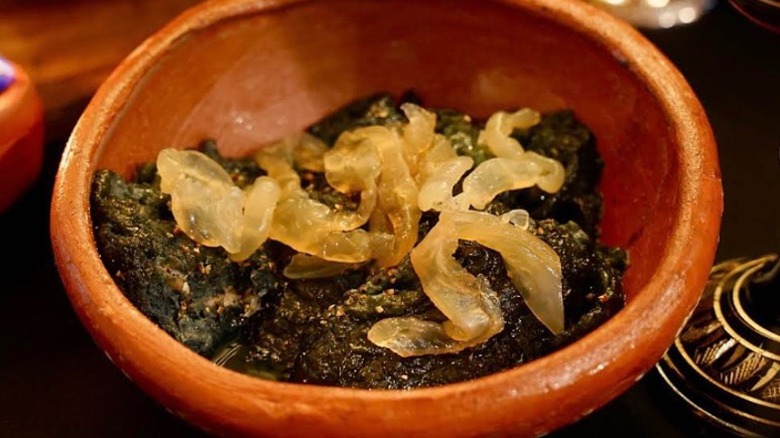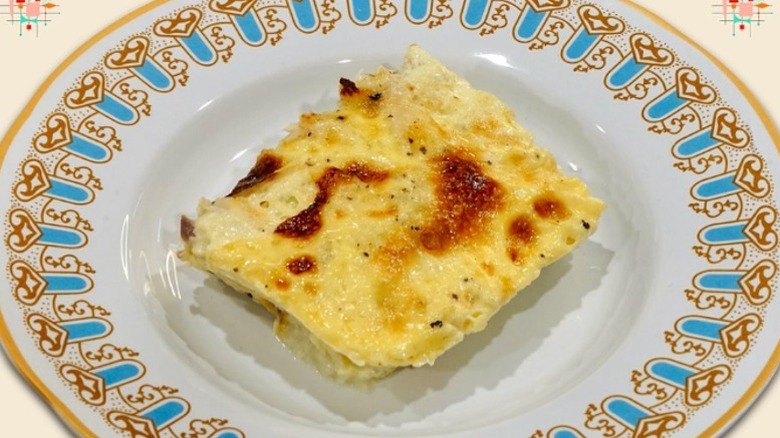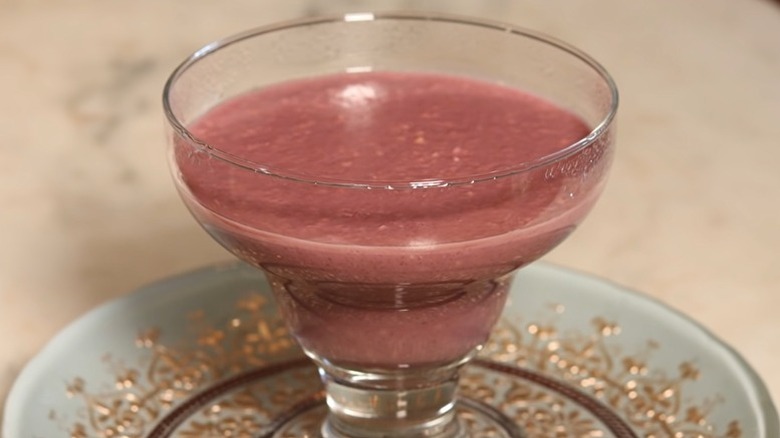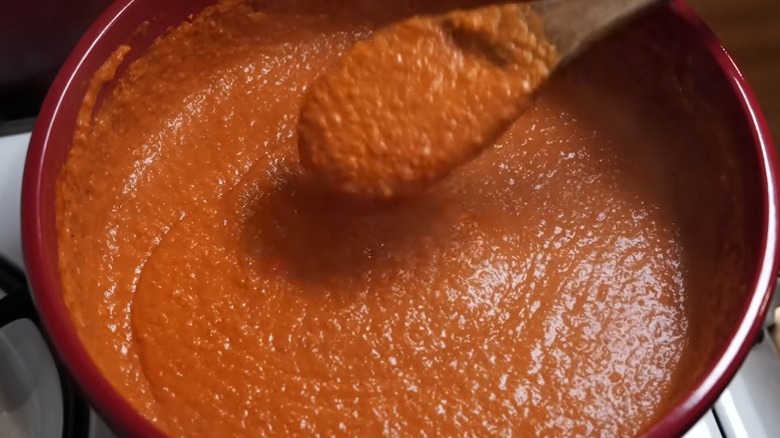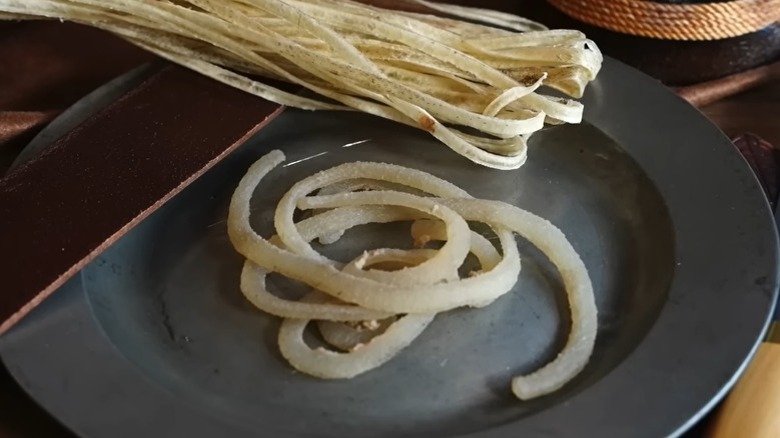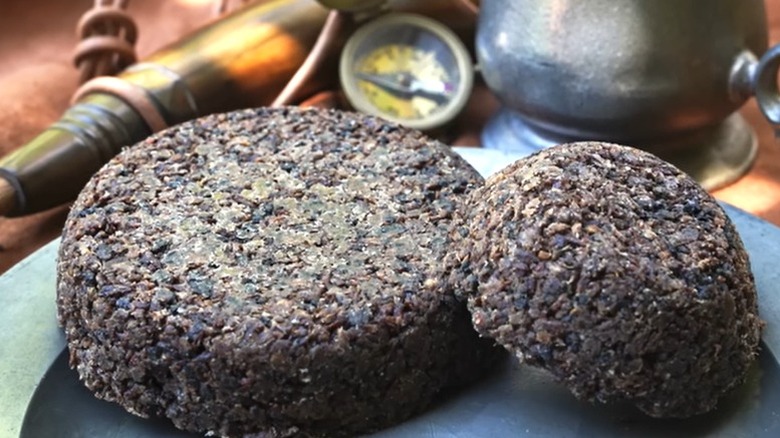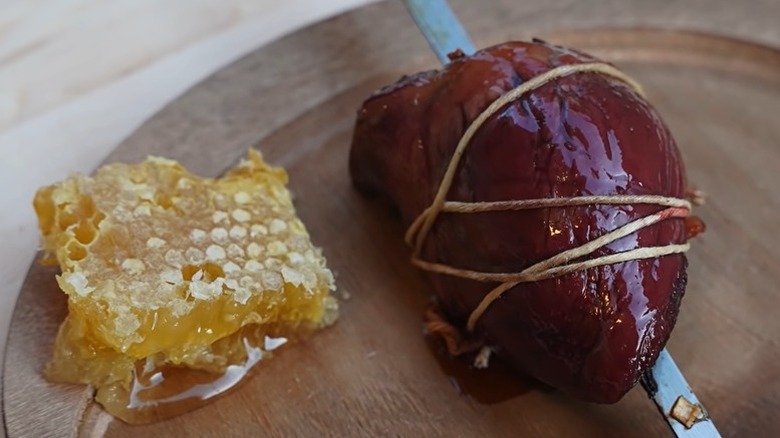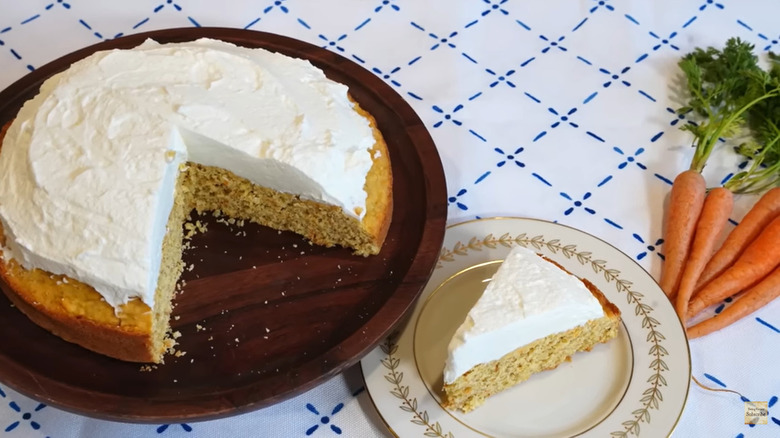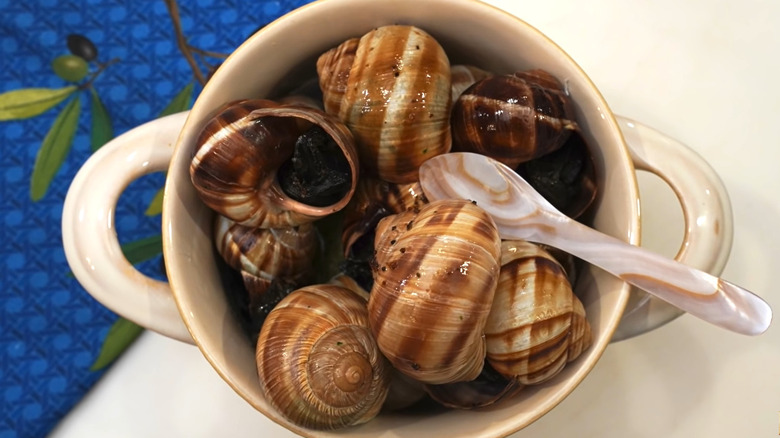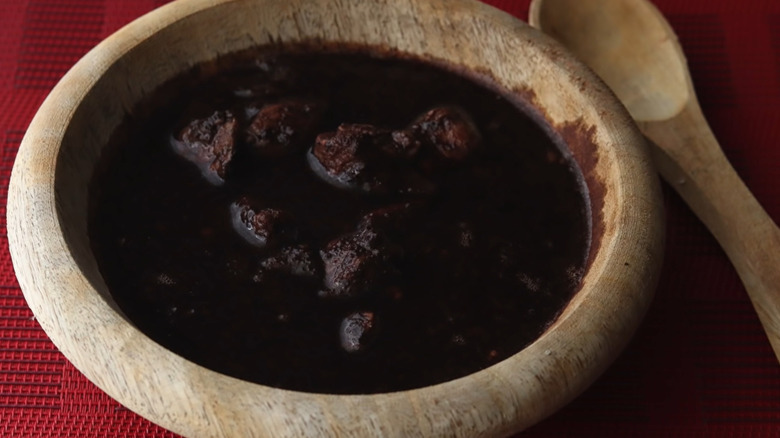11 Foods Max Miller From Tasting History Didn't Like
Before launching the popular YouTube channel "Tasting History With Max Miller," Max Miller had already combined his love of history and baking into a hobby. Before social media fame, he would make dishes from historical recipes and bring them into the office to share, telling coworkers what he had learned about the dish. Around Christmas of 2019, one of those work friends suggested he take this knowledge to YouTube. After being furloughed from his job with Disney Studios in the early days of the COVID-19 pandemic, Miller decided to do just that.
What started as a pandemic project quickly turned into a new career. In April of 2021, Miller made what he called one of the most difficult decisions ever and quit what had been a dream job with Disney to pursue "Tasting History" full-time. He had already begun work on a cookbook with major publishing house Simon & Schuster, which eventually came out in April 2023 and is appropriately entitled "Tasting History." He runs another channel with his husband Jose Mendoza, presenting a behind-the-scenes peek called "Ketchup With Max and Jose."
With over 200 videos focusing on historical dishes from across the globe, Miller can't like them all. However, he often notes that even some of the strangest-sounding dishes are not without merit. But there are a rare few with zero redeeming qualities. Read on to learn about the foods that Max Miller just didn't like.
Jellyfish
In October 2022, "Tasting History With Max Miller" featured what is possibly the most morbid dinner party in history: the Black Banquet thrown by the infamous Roman emperor Domitian, where everything that could be made black was. The hall and attendants were draped in black, while the food was dyed black and served in black dishware. Each of the guests was seated with a tombstone engraved with their name. Though many were convinced they were about to be killed (perhaps poisoned by the meal itself), none of the guests died. In fact, they were given expensive gifts after they had safely arrived back home.
Aside from the twisted atmosphere, some of the dishes that may have been served don't sound so great. The recipe for this episode was a genuine Roman recipe from an ancient cookbook known as the "Apicius." It was originally deemed a "patina of anchovies without anchovies," (the Roman patina was essentially a casserole made with eggs) but Miller more appropriately renamed it a patina with jellyfish.
This dish contained eggs, tilapia, and cuttlefish ink to make it black. But those ingredients weren't the problem. It was the jellyfish on top that was unpalatable. Though Romans at the time may have prized this particular ingredient, it simply was not for Miller. He compared the texture to cartilage and said it was impossible to bite through.
Fish pudding
This may automatically sound disgusting to some, but fish pudding — perhaps better known as fiskegrot — is a traditional Norwegian dish enjoyed by several people. But that was not the case with the fish pudding recipe from the 1954 cookbook "The ABC of Casseroles" that Max Miller used in one episode of "Tasting History."
One key difference between traditional fiskegrot recipes and the 1954 one that Miller used was the addition of rice to the latter, but that was unlikely to affect the flavor. In the "Tasting History Wins and Flops 2022" episode of "Ketchup with Max and Jose," Miller concluded, "That's probably the second-most disgusting thing I've had, and it would have been number one if it had been black like the jellyfish."
However, there are always exceptions. One person in the comments section noted, "As a Brit, looking at food that appears both bland and horrifying at the same time gives me a sense of warm childhood nostalgia..." To each their own.
Hardtack
Hardtack, a dense, flat, and almost entirely nonperishable bread once used as rations for lengthy sea voyages and military campaigns, has been featured multiple times on "Tasting History." Often, Miller says the word hardtack and a brief clip of him clacking two pieces of the food together is shown.
In "How to Eat Like a Pirate: Hardtack and Grog," Miller called the hardtack (also known as ship's biscuit), "Crispy and flavorless!" He clarified the statement, saying, "There's a little flavor, it's just not very good. [...] I can see why Polly want a cracker and not a ship's biscuit. Smart parrot."
A year later, Miller used the very same hardtack from the pirate episode (we told you it was nonperishable) to create a Civil War dish called Hell Fire Stew. The hardtack was crumbled up in the stew, allowing it to soften. Miller said the resulting consistency reminded him of chorizo and was actually edible.
Kykeon
Kykeon is usually described as a beverage, though the consistency of this ancient Greek drink is more like a modern-day smoothie. There is no one recipe for this dish, though water and barley meal are consistently mentioned as part of kykeon in ancient texts. In the Greek poet Homer's epic works, the "Iliad" and the "Odyssey," wine, herbs, and ground cheese are added to kykeon as well. When used in ritual, it is thought that psychoactive substances were a part of the mix, too. The Romans, who also enjoyed kykeon, incorporated wine, honey, and herbs.
The kykeon that Max Miller prepared on "Tasting History" was based on Homer's two epics. The word itself comes from a term meaning to stir until thick, so Miller employed this technique when mixing the ingredients over low heat. The result was a reddish-purple porridge that smelled like wine.
Miller seemed to have a little trouble swallowing his first sip of kykeon, saying afterward, "It tastes like what you think it would, which isn't good." Laughing, he added, "I cannot in good conscience have anyone else make this." After a second sip, Miller concluded, "That's not good. That's not good at all."
Peanut butter and tomato soup
The Great Depression was, for many, a traumatic period of U.S. history that affected all parts of society, including how people ate. Because so many were out of work and going hungry, the federal government bought food from U.S. farmers and used it to create a public school lunch program. As part of the Works Progress Administration, the program also hired people to cook and serve those meals.
In the episode "School Lunch from the Great Depression," Miller recreated an entire meal that school children ate in 1934. This included a glass of milk, an apple, a butter sandwich, a cookie, and peanut butter and tomato soup. Only the latter two required a recipe. The cookie was a pretty basic cookie that tasted just fine. As for the soup, however, Miller was not a fan.
What went wrong? The texture of the soup was quite thick and, in Miller's words, "gloopy." After taking his first bite and going through a myriad of facial expressions, Miller set down his bowl and said, "Oh, those poor children." He clarified that although the soup didn't taste bad, it also didn't taste good. He argued that the flavors of tomato and peanut butter, while satisfying on their own, should never have been mixed together.
Leather
Real leather is made from animals and is therefore technically edible. But it is also definitely something that humans throughout history have resorted to only when they are desperate and very literally starving. Such was the case when 17th-century privateer Henry Morgan led his crew against the Spanish city of Panama in 1671. One of the privateers under Morgan's command wrote that, among other things, they grew so hungry that they ate their belts and other pieces of leather.
Before getting into the process of how they prepared the leather for consumption, Miller implored his audience to leave the consuming up to him. Modern leather, which is often processed far differently than it was in the 17th century, is generally not safe to eat. For this episode, Miller obtained strips of untanned leather hide.
Once it had been softened and cooked, he compared the rubbery, noodle-like strip to the jellyfish he had tried in an earlier episode, saying it was intensely chewy and completely flavorless. He noted that while it was cooking, the kitchen smelled like leather, but that was all gone when it came time to eat the stuff. Tiny pieces of the meal also stuck to his teeth.
Pemmican
Pemmican is very similar to hardtack, as it was often used as rations for long voyages, though typically over land rather than by sea. However, pemmican is a hard, dried puck made from meat, fat, and sometimes berries or sugar. The name comes from the Cree word for "processed fat," though many American Indian tribes have been known to make this survival food.
Miller chose to make his pemmican from bison meat. Because the meat for pemmican is dried (often intensely), the flavor unsurprisingly bears a resemblance to beef jerky. Pemmican is crumbly, at least as Miller made, and the fat unpleasantly coated the inside of his mouth. Miller chose to add berries to his pemmican, though he didn't think added much to the flavor. He suggested using sugar if this recipe were made again. He also suspected that using pemmican as an ingredient in a stew, as was done in times past, would be preferable to eating it on its own.
Roasted pig heart
Heart is a lean meat that, like other organ meats, is high in vitamins and minerals. Throughout history, consuming organ meat has been considered to be many things: a taboo, a delicacy, and peasant food, depending on the time and culture. For instance, Scotland's national dish is haggis, which uses sheep's heart as a main ingredient alongside the animal's lungs and liver. So, a roasted pig's heart isn't necessarily bad. In fact, Max Miller said that he enjoyed haggis when he tried it during a trip to Scotland.
However, Max Miller, as discovered in the episode "Dragon Heart for a Viking King," an ancient Norse dish made with roasted pig heart was a whole different animal. "Heart is not for me," he said with a downcast face. "I don't have the stomach for heart, it turns out." While roasting, the heart was basted with honey, a flavor that came through in the final dish. But the real issue was the texture, which Miller described as overly firm due to the lack of fat.
World War II carrot cake
Carrot cake may not be your first choice for a birthday cake, but that is what Max Miller chose for himself in 2023. In honor of the occasion, he featured a 1943 carrot cake recipe, from an era when several foods, including sugar and butter, were subject to wartime rationing in the U.S. and U.K. Carrot cake became popular at this time because the natural sweetness of carrots helped make up for the shortage of granulated sugar.
As far as the flavor of the cake went, Miller concluded unenthusiastically that it was "good, but it doesn't taste like carrots" — not a great review for something with carrot in its name. "At the very, very end, maybe I could see that this cake was once introduced to a carrot," Miller continued. He lamented that more carrots hadn't been used in the recipe, arguing that this would have improved both the flavor and the sweetness of the cake. Even the addition of whipped cream (which likely would have been acquired on the black market at the time) could not save this recipe.
Ancient Roman snails
Snails have been popular in Mediterranean cuisine for many centuries, as evidenced by modern culinary traditions like French escargot. Then, there are ancient Rome's cocleas, the focus of the "Tasting History" episode "Ancient Roman Fast Food Restaurants." Yes, snails were considered fast food in the ancient Roman Empire. And quick-service spots were popular in the bustling empire, as such restaurants have been uncovered by archaeologists in Pompeii.
This particular recipe for snails fried in olive oil comes from an ancient cookbook Miller has encountered before, the Roman "Apicius." As for serving tips, Miller tells viewers to eat the snails while they are still warm "because nothing is more disgusting than cold snails." Unlike modern escargot dishes, where butter and garlic feature quite prominently, the dominant flavor in this ancient Roman dish was the snail itself. The only other seasonings were asafoetida, ground pepper, and fish sauce, which brought a significant briny taste to the dish.
Having tried both escargot and cocleas, Miller didn't hold back. He recommended that viewers "stick with the garlic and butter of modern-day escargot."
Spartan black broth
Travel across the Ionian Sea to Sparta of ancient Greece for a nice hot bowl of melas zomos, also known as black broth. Spartan black broth had a bad reputation among the other Greek city-states. Perhaps because of this, no one thought to leave behind a recipe, but historians have managed to piece together the probable ingredients.
We know for certain that it featured pork. Because of the dark color, we can assume that it also included pig's blood much like the similarly-hued British black pudding. Blood certainly seems to be fitting fare for a Spartan warrior. There are also blood soups in the cuisines of modern Germany, Eastern Europe, and the Phillippines that eaters can draw from when recreating this ancient dish.
Miller did not find the Spartan black broth to be as "horrific" as non-Spartan Greek contemporaries did. The dominant scents were vinegar, used to keep the blood from coagulating, and pork. As for the taste, it was also vinegary and "fine." Said Miller, "I wouldn't want it. I'm never going to crave this." He concluded that "it's just kind of flavorless." He did not necessarily recommend viewers make it at home.

